
 Known as a great food wine, Grüner Veltliner can compete with top chardonnays and burgundies—although it has a flavor profile unique unto itself.
Known as a great food wine, Grüner Veltliner can compete with top chardonnays and burgundies—although it has a flavor profile unique unto itself.
|
R. VERONIQUE FITZGERALD is wine consultant and writer in New York City.
|
|
May 2007 |
 |
Product Reviews / Main Nibbles / Wine
Grüner Veltliner:
The Gru-Ve Wine From Austria
CAPSULE REPORT: Feeling groovy—or gru-ve, as lovers of GV are known to ask? Learn about—and be sure to try—Grüner Veltliner, a crisp and wonderful white wine from Austria. It’s one of our favorites.
Austria is home to many very interesting wines made from varieties unique to the region. Its wine regions, like all of its agricultural land, are concentrated in the eastern part of the country. With spring in full swing, its a good time to try an Austrian classic, Grüner Veltliner (pronunciation of the umlaut ü is a cross between GROO-ner and GREE-ner, and Veltliner is pronounced as it appears, VEHLT-ly-ner). Often called Grüner, Gru-Ve or simply GV, this is Austria‘s most widely planted grape, accounting for over one-third of the vineyard plantings in the country. It is also grown in the Czech Republic and Hungary, and wine regions outside of Europe are experimenting with small plantings.
Some sources say that Grüner Veltliner dates back to Roman times, but the name only 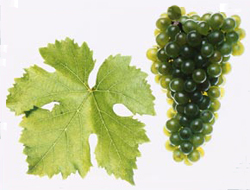 appeared in the mid-19th century. Before that time it was known as Grüner Muskateller, and was not an exceptional wine until skillful viticulture post-World War II learned how to get the most from the grape. According to recent DNA analysis, the Traminer grape is one of its parents. Grüner means green in German: The wine is also called Green Veltliner, acknowledging the deep green-colored grapes that ripen in mid-late October. appeared in the mid-19th century. Before that time it was known as Grüner Muskateller, and was not an exceptional wine until skillful viticulture post-World War II learned how to get the most from the grape. According to recent DNA analysis, the Traminer grape is one of its parents. Grüner means green in German: The wine is also called Green Veltliner, acknowledging the deep green-colored grapes that ripen in mid-late October.
Photo courtesy of WinesFromAustria.com.
Grüner’s most impressive talent is to translate the soil in which the grapes are grown through the minerality in the wine. It gives wines that are typically dry and medium- to full-bodied. From the vineyards of the Danube west of Vienna, which are so steep that they barely contain any soil, the grapes produce very pure, minerally Grüner Veltliners 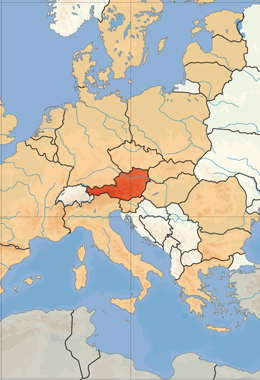 intended for laying down. It has been compared to the great white wines of Burgundy, which are made from Chardonnay, but are equally capable of graceful aging under careful storage: In blind tastings organized by the Austrian Wine Marketing Board, Grüner Veltliners have beaten world-class Chardonnays from Louis Latour and Robert Mondavi. In the deeper clay soils in the plains of the Weinviertel to the northeast of Vienna, citrus and peach flavors are more apparent, with spicy notes of pepper and sometimes tobacco. While it can be aged if manipulated appropriately in the production process, is intended to be drunk young in heurigen bars or made into sekt, sparkling wine. Older GV often takes on intriguing petrol and honeycomb aromas, more reminiscent of the Riesling and Gewürtztraminer grapes of Germany and the Alsace region of France. intended for laying down. It has been compared to the great white wines of Burgundy, which are made from Chardonnay, but are equally capable of graceful aging under careful storage: In blind tastings organized by the Austrian Wine Marketing Board, Grüner Veltliners have beaten world-class Chardonnays from Louis Latour and Robert Mondavi. In the deeper clay soils in the plains of the Weinviertel to the northeast of Vienna, citrus and peach flavors are more apparent, with spicy notes of pepper and sometimes tobacco. While it can be aged if manipulated appropriately in the production process, is intended to be drunk young in heurigen bars or made into sekt, sparkling wine. Older GV often takes on intriguing petrol and honeycomb aromas, more reminiscent of the Riesling and Gewürtztraminer grapes of Germany and the Alsace region of France.
Map of Europe (Austria highlighted in red) courtesy of Wikipedia.com.
Hot, dry summers make it possible to cultivate this late-ripening grape. The regions of Wachau, Kamptal, Kremstal, Weinviertel and Donauland, as well as some specialists in Vienna, have the best success with GV. In Austria, one can find Grüner sparkling in sekt, Austria’s national bubbly; opulent and concentrated in a single vineyard bottling, or as a fresh, young heurige.
Young Grüner
Heurige, or new wine, is Austria’s answer to Beaujolais Nouveau. In Austrian wine culture, it is used to describe a wine from the new vintage that is feted with as much fervor as nouveau, on a slightly earlier release date—November 11, St. Martin’s Day.* They hold the title until the following November, when they become alt wine. In general, upper tier wines will mature in vats or barrels for later release. Because Austria’s standards in wine production are so exacting, high quality heurige is not hard to find.
*Martinmas, November 11, the feast day of Martin of Tours, a 4th century Roman soldier who became a monk, and was later appointed Bishop of Tours. The holiday is much like Halloween, with children carrying lanterns and eating a sweet bread roll shaped like a gingerbread man. St. Martin’s Day is also the official start of Karneval, Fasching and Fastnacht: At eleven minutes past eleven on the eleventh day of the eleventh month, carnival clubs and neighborhood groups start their preparations for the carnival season that culminates with the big Fasching (Mardi Gras) parades in February. St. Martin’s Day also marks the end of the agrarian year and the start of the harvesting season.
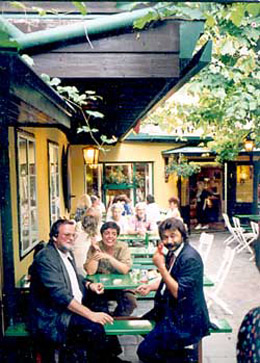
Enjoying wine and food alfresco at the Bach-Hengt
heuriger in Sandgasse, Austria. Did Bill Clinton eat
there? There’s a photo on the website, but we can’t
read the fine print. |
Traditionally, a heuriger is a wine bar that is family owned and located at the cellar door (although there are sophisticated and happening heurigen in Vienna and other cities). These little bars are scattered throughout Austria’s wine regions, and are a popular tourist destination, especially in the Viennese suburbs and further south in Thermenregion. Because the law that sanctions them, created in 1784, allows “vine dressers” to sell “provisions, such as wine” from one's “own production,” the heuriger also sells homemade foods on a buffet. Most proprietors keep a sporadic schedule, so a bundle of pine sprigs hung above the doorway of a heuriger tells you they’re open and serving heurige and other house wines. A heuriger is also known as a buschenshack, because of their tradition of displaying this bunch, or busch, of pine. They often have outdoor tables, so you can enjoy local wine and food al fresco on a sunny day. Some are quite beautifully landscaped: a haven for good food, wine and atmosphere.
|
Recommended Bottlings
Grüner is a great food wine: a white wine that can be enjoyed with poultry and pork as well as seafood and other dishes traditionally enjoyed with white wine. Although these wines can hold up to aging, do choose the most recent vintages (2005 or younger) in the shops.
- Höpler Grüner Veltliner 2004 Burgenland ($12.00) was a perfect accompaniment to the recipe below. It showed lots of scallion and herbs on the nose and palate, as well as fresh crisp melon fruit through a healthy length. I tasted the 2006 for this article, a bona-fide heurige, which is bottled with a natural cork. It had a lovely freshness to it with green bell pepper on the nose and black pepper and spice on the palate.
- From Kamptal, Loimer Grüner Veltliner 2005 and Lois Grüner Veltliner 2006, both around $10.00 and both in screw cap, were pretty wines. The Loimer, easy to spot with its distinctive green label, had a complex nose with youthful hints of nutmeg, spice and black pepper and overtones of lanolin—definitely a food wine.
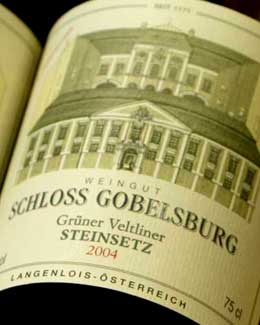 Crisp acidity lifts a full, savory palate with ginger and scallion notes. The Lois, also bottled by Fred Loimer, smelled like freshly cut grass, and was also crisp but lighter with a slight spritz. It was fresh and simple, with enough citrus fruit to be enjoyed without food. All of these wines tasted better well chilled, although each was unique enough to work in different contexts. Crisp acidity lifts a full, savory palate with ginger and scallion notes. The Lois, also bottled by Fred Loimer, smelled like freshly cut grass, and was also crisp but lighter with a slight spritz. It was fresh and simple, with enough citrus fruit to be enjoyed without food. All of these wines tasted better well chilled, although each was unique enough to work in different contexts.
- You can add some very special Grüners from treasured vineyard sites to your collection: Look for wines by Schloss Gobelsburg or the Biodynamic estate Nikolaihof. These will retail as high as $25.00, quite a bargain for their outstanding quality compared to similarly special white wines from other countries. (For example, a basic Sancerre or Chablis starts around $18.00, while high-end Sauvignon Blanc from California can run you as much as $40.00).
Photo of Schloss Gobelsburg courtesy of EnglewoodWineMerchants.com.
- Fred Loimer also makes single vineyard wines that retail for closer to $17.00. Also look for groovy Gru-Vees from Leth, Angerer, Brundlmayer and Undhof Salomon.
- Grüner Veltliner can also make fantastic late harvest styles, or beerenauslese, that sell for $25.00 or more a half bottle. Alois Kracher and Hafner are favorite producers of these styles.

Pair
Grüner with vegetables. The Asparagus Gratin shown above is available from MackenzieLtd.com.
|
Pairings
Pair Grüner Veltliner with:
- Asian dishes: oyster sauce, peanut sauce, stir-fries, Cold Noodles with Tofu in Peanut Sauce
- Cheese dishes
- Lighter meats: poultry, pork, veal (try especially with chicken skewers and satays)
- North African cuisine (or any dishes spiced with caraway, coriander and cumin)
- Seafood (wonderful with meatier white fish like bass and cod, and all shellfish)
- Soups (savory as well as fruit soups—pair the savory with the minerally wines and the fruit soups with the heurige wines)
- Tofu dishes
- Vegetable dishes (wonderful now with the season’s asparagus)
|
Recipe: Chicken With Tarragon Goat Cheese Pockets
Last May, my husband Shehu Fitzgerald, a professional chef, and I had a delicious dinner with which we enjoyed a 2004 Grüner Veltliner. We enjoyed the meal so much that we wrote it down in our culinary journal. It’s a simple dish with lots of fresh herbs to complement a warm, hearty meat preparation. The recipe works year-round: Substitute the greens for squash or tubers to winterize, or rework the chicken for the barbecue grill for a summer spin.
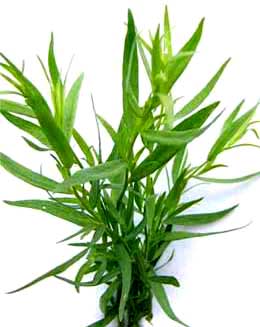 Ingredients Ingredients
- 2 6-8 ounces whole chicken breasts with the wing bone still attached, frenched (wing bone cleaned)
- 4-5 ounces goat cheese, at room temperature
- 1 bundle fresh tarragon (for the goat cheese, sauce and salad)
- 1 shallot, minced
- 2-3 ounces sundried tomatoes, julienned (include some yellow ones if you can find them, to make the mix colorful)
- 1/2 tablespoon extra virgin olive oil, plus some for sautéing
Mire Poix
- 1 large yellow onion (peeled), 1 medium carrot (peeled) and 1 stalk of celery, cut into 1/2" pieces
- 1 tablespoon butter
- 1 tablespoon flour
- 1 teaspoon tomato paste
- 1/2 cup oxidized Chianti†
- Chicken or vegetable stock
†Chianti or any light- to medium-bodied red wine will do: Cabernet Franc, Toscana Rosso, Montepulciano d’Abruzzo or Zweigelt. Leave the unconsumed portion of a bottle of wine for at least 7 days on your kitchen counter. The warmer the kitchen, the faster it will oxidize.
Salad Greens
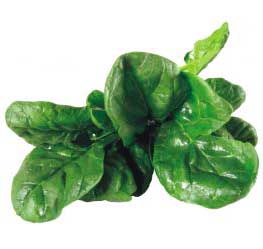 We chose a crisp spinach salad, but you can choose another green (or a mix), and have as much as you like: They’re low in calories and high in vitamins and minerals. We’ve chosen complementary herbs below, but you can add or substitute basil, parsley, coriander, mint etc. to your heart’s content. They add layers of flavor. Use a scissors to snip them over the greens. We chose a crisp spinach salad, but you can choose another green (or a mix), and have as much as you like: They’re low in calories and high in vitamins and minerals. We’ve chosen complementary herbs below, but you can add or substitute basil, parsley, coriander, mint etc. to your heart’s content. They add layers of flavor. Use a scissors to snip them over the greens.
- Baby spinach, stems and spines removed
- Fresh chervil
- Fresh oregano leaves
- Whole chives
- Extra virgin olive oil and balsamic vinegar for dressing
Tools
- Chinois or fine mesh sieve
- Flat baking sheet or sizzle platter (for baking the chicken breasts)
- Large saute pan
- Oven preheated to 350°F
Directions
- Make the tarragon goat cheese (this can be done a few days ahead). Mince 1 tablespoon tarragon, add salt, pepper, shallot and 1/2 tablespoon olive oil; whip all ingredients into the goat cheese until creamy. Fold in the sundried tomatoes. Place it in a piping bag and set aside.
- Preheat a large sauté pan. With a long, slender knife, cut a pocket into the chicken breasts at the meatier end near the bone. Pipe the the tarragon goat cheese into the pocket. Sear breasts skin side down over high heat until golden, then put them in the oven on a baking sheet or sizzle platter and bake 10-15 minutes or until done.
- Next, sauté the mire poix in 1 tablespoon olive oil over high heat for two to three minutes. Turn the heat down to medium high and add until butter melts and coats the vegetables. Add flour and cook until slightly pasty. Add tomato paste and cook until the tomato paste starts to caramelize.
- Deglaze the pan with the oxidized wine and reduce by half over low heat. Then, add the stock and reduce by half. Pass the sauce through the sieve, then add the salt and pepper to taste, and add the whole tarragon leaves to infuse for a few minutes; then remove the leaves.
- TO SERVE: Plate the chicken with a mixture of the greens and fresh tarragon leaves. You can drizzle a little extra virgin olive oil and golden balsamic vinegar on them, and salt and pepper them to your taste. The salad contributes freshness, crunch, healthy green colors and herbaceous aromas and flavors to the plate.
Enjoy those Gru-Ves.
Lifestyle Direct, Inc. All rights reserved. Images are the copyright of their respective owners.

|





 appeared in the mid-19th century. Before that time it was known as Grüner Muskateller, and was not an exceptional wine until skillful viticulture post-World War II learned how to get the most from the grape. According to recent DNA analysis, the Traminer grape is one of its parents. Grüner means green in German: The wine is also called Green Veltliner, acknowledging the deep green-colored grapes that ripen in mid-late October.
appeared in the mid-19th century. Before that time it was known as Grüner Muskateller, and was not an exceptional wine until skillful viticulture post-World War II learned how to get the most from the grape. According to recent DNA analysis, the Traminer grape is one of its parents. Grüner means green in German: The wine is also called Green Veltliner, acknowledging the deep green-colored grapes that ripen in mid-late October. intended for laying down. It has been compared to the great white wines of Burgundy, which are made from Chardonnay, but are equally capable of graceful aging under careful storage: In blind tastings organized by the Austrian Wine Marketing Board, Grüner Veltliners have beaten world-class Chardonnays from Louis Latour and Robert Mondavi. In the deeper clay soils in the plains of the Weinviertel to the northeast of Vienna, citrus and peach flavors are more apparent, with spicy notes of pepper and sometimes tobacco. While it can be aged if manipulated appropriately in the production process, is intended to be drunk young in heurigen bars or made into sekt, sparkling wine. Older GV often takes on intriguing petrol and honeycomb aromas, more reminiscent of the Riesling and Gewürtztraminer grapes of Germany and the Alsace region of France.
intended for laying down. It has been compared to the great white wines of Burgundy, which are made from Chardonnay, but are equally capable of graceful aging under careful storage: In blind tastings organized by the Austrian Wine Marketing Board, Grüner Veltliners have beaten world-class Chardonnays from Louis Latour and Robert Mondavi. In the deeper clay soils in the plains of the Weinviertel to the northeast of Vienna, citrus and peach flavors are more apparent, with spicy notes of pepper and sometimes tobacco. While it can be aged if manipulated appropriately in the production process, is intended to be drunk young in heurigen bars or made into sekt, sparkling wine. Older GV often takes on intriguing petrol and honeycomb aromas, more reminiscent of the Riesling and Gewürtztraminer grapes of Germany and the Alsace region of France. 
 Crisp acidity lifts a full, savory palate with ginger and scallion notes. The Lois, also bottled by Fred Loimer, smelled like freshly cut grass, and was also crisp but lighter with a slight spritz. It was fresh and simple, with enough citrus fruit to be enjoyed without food. All of these wines tasted better well chilled, although each was unique enough to work in different contexts.
Crisp acidity lifts a full, savory palate with ginger and scallion notes. The Lois, also bottled by Fred Loimer, smelled like freshly cut grass, and was also crisp but lighter with a slight spritz. It was fresh and simple, with enough citrus fruit to be enjoyed without food. All of these wines tasted better well chilled, although each was unique enough to work in different contexts. 
 Ingredients
Ingredients We chose a crisp spinach salad, but you can choose another green (or a mix), and have as much as you like: They’re low in calories and high in vitamins and minerals. We’ve chosen complementary herbs below, but you can add or substitute basil, parsley, coriander, mint etc. to your heart’s content. They add layers of flavor. Use a scissors to snip them over the greens.
We chose a crisp spinach salad, but you can choose another green (or a mix), and have as much as you like: They’re low in calories and high in vitamins and minerals. We’ve chosen complementary herbs below, but you can add or substitute basil, parsley, coriander, mint etc. to your heart’s content. They add layers of flavor. Use a scissors to snip them over the greens.